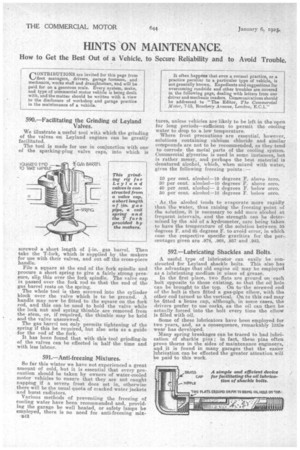HINTS ON MAINTENANCE.
Page 26

If you've noticed an error in this article please click here to report it so we can fix it.
How to Get the Best Out of a Vehicle, to Secure Reliability and to Avoid Trouble.
590.—Facilitating the Grinding of Leyland Valves.
We illustrate a useful tool wita which the grinding of the valves on Leyland engines can be greatly facilitated.
The tool is made for use in conjunction with one of the sparking-plug valve caps, into which is screwed a short length of Z-in. gas barrel. Then take the T-fork, which is supplied by the makers for use with their valves, and cut off the cross-piece handle.
File a square at the end of the fork spindle and procure a short spring to give a fairly strong pressure, slip this over the fork spindle. The valve cap is passed over the fork rod so that the end of the gas barrel rests on the spring. The whole tool is then screwed into the cylinder block over the valve which is to be ground. A handle may now be fitted to the square on the fork rod, and this can be used to hold the valve while the lock nut and spring thimble are removed from the stem, or, if required, the thimble may be held and the valve unscrewed.
The gas barrel not only permits tightening of the spring if this be required, but also acts as a guide for the rod of the fork.
It has been found that with this tool grinding-in of the valves can be effected in half the time and with less labour.
591.—Anti-freezing Mixtures.
So far this winter we have not experienced a great amount of cold, but it is essential that every precaution should be taken by owners of water-cooled motor vehicles to ensure that they are not caught napping if a severe frost does set in, otherwise there will be the usual quota of cracked water jackets and burst radiators.
Various methods of preventing the freezing of cooling water have been recommended and, providing the garage be well heated, or safety lamps be employed, there is no need for anti-freezing mixB42 tures, unless vehicles are likely to be left in the.open for long periods—sufficient to permit the cooling water to drop to a low temperature.
Where frost precautions are essential, however, solutions containing calcium chloride and similar compounds are not to be recommended, as they tend' to corrode the metal parts of the cooling system. Commercial glycerine is used in some instances, but is rather messy, and perhaps the best material is denatured alcohol, which, when mixed with water, gives the following freezing points:—
al per cent. alcohol-19 degrees F. above Lerroo.. 30 per cent. alcohol-10 degrees F. above 40 per cent. alcohol— 2 degrees F. below zero. 50 per cent. alcohol-18 degrees F. below zero.
As the alcohol tends to evaporate more rapidly than the water, thus raising the freezing point of the solution, it is necessary to add more alcohol at frequent intervals, and the strength can be determined by the aid of a hydrometer, care being taken to have the temperature of the solution between 55 degrees F. and 65 degrees F. to avoid error, in which case the respective specific gravities for the percentages given are .978, .968, .957 and .943.
592.—Lubricating Shackles and Bolts.
A. useful type of lubricator can easily be constructed for Leyland shackle bolts. This also has the advantage that old engine oil may be employed as a lubricating medium in place of grease.
In the first place, two flats are ground on each bolt opposite to those existing, so that the oil hole can be brought to the top. On to the screwed end of the bolt is then fitted a gas-pipe elbow, with the other end turned to the vertical. On to this eiad may, be fitted a brass cap, although, in some cases, the drivers prefer to use corks, as the oil can then be actually forced into the bolt every time the elbow is filled with oil.
Some of these lubricators have been employed for two years, and, as a consequence, remarkably little wear has developed.
Many spring breakages can be traced to bad lubrication of shackle pins ; in fact, these pins often prove thorns in the sides of maintenance engineers, and it is found in many, garages that the easier lubrication can be effected the greater attention will be paid to this work.




























